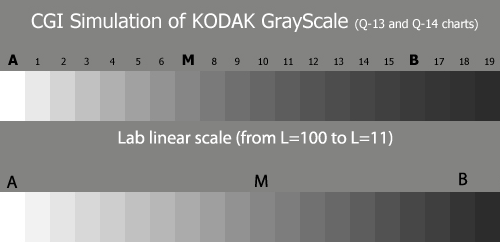In the photographic community, the common perception is that the exposition scale is symmetrical. The perception dates back to Adams: the Zone V is in the middle of the range, with 5 zones above and below it, top and bottom being symmetrical: there are 2 zones each way containing details, then one more each way with traces of textures, with the final two (one each way) which are respectively completely void white and solid black. The 2x (1eV) changes in brightness correspond to the transition between the zones.
 The photographic zone step wedge is not visually (perceptually) even. For instance in the Kodak Q13 grey wedge (the top scale on the image to the left), where the distance between the two neighboring patches is 1/3 eV, we can clearly see that in the lighter part, this distance between the patches seems visually large, and in shadows visually small, as if the steps are compressed. The Q13 wedge encompasses Zones I through VII, although not representing the brightest part (further on, we will see that they cannot be represented at all by an evenly distributed wedge).
The photographic zone step wedge is not visually (perceptually) even. For instance in the Kodak Q13 grey wedge (the top scale on the image to the left), where the distance between the two neighboring patches is 1/3 eV, we can clearly see that in the lighter part, this distance between the patches seems visually large, and in shadows visually small, as if the steps are compressed. The Q13 wedge encompasses Zones I through VII, although not representing the brightest part (further on, we will see that they cannot be represented at all by an evenly distributed wedge).
Recent comments